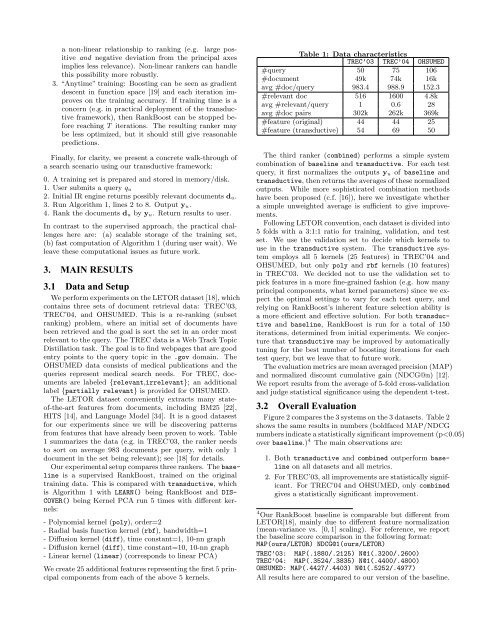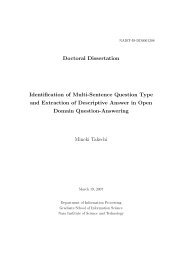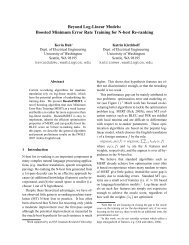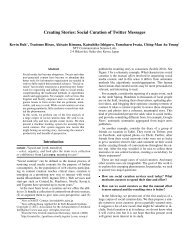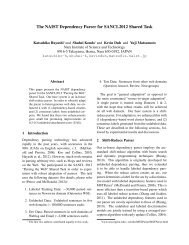Learning to Rank with Partially-Labeled Data - University of ...
Learning to Rank with Partially-Labeled Data - University of ...
Learning to Rank with Partially-Labeled Data - University of ...
You also want an ePaper? Increase the reach of your titles
YUMPU automatically turns print PDFs into web optimized ePapers that Google loves.
a non-linear relationship <strong>to</strong> ranking (e.g. large positive<br />
and negative deviation from the principal axes<br />
implies less relevance). Non-linear rankers can handle<br />
this possibility more robustly.<br />
3. “Anytime” training: Boosting can be seen as gradient<br />
descent in function space [19] and each iteration improves<br />
on the training accuracy. If training time is a<br />
concern (e.g. in practical deployment <strong>of</strong> the transductive<br />
framework), then <strong>Rank</strong>Boost can be s<strong>to</strong>pped before<br />
reaching T iterations. The resulting ranker may<br />
be less optimized, but it should still give reasonable<br />
predictions.<br />
Finally, for clarity, we present a concrete walk-through <strong>of</strong><br />
a search scenario using our transductive framework:<br />
0. A training set is prepared and s<strong>to</strong>red in memory/disk.<br />
1. User submits a query q u<br />
2. Initial IR engine returns possibly relevant documents d u.<br />
3. Run Algorithm 1, lines 2 <strong>to</strong> 8. Output y u.<br />
4. <strong>Rank</strong> the documents d u by y u. Return results <strong>to</strong> user.<br />
In contrast <strong>to</strong> the supervised approach, the practical challenges<br />
here are: (a) scalable s<strong>to</strong>rage <strong>of</strong> the training set,<br />
(b) fast computation <strong>of</strong> Algorithm 1 (during user wait). We<br />
leave these computational issues as future work.<br />
3. MAIN RESULTS<br />
3.1 <strong>Data</strong> and Setup<br />
We perform experiments on the LETOR dataset [18], which<br />
contains three sets <strong>of</strong> document retrieval data: TREC’03,<br />
TREC’04, and OHSUMED. This is a re-ranking (subset<br />
ranking) problem, where an initial set <strong>of</strong> documents have<br />
been retrieved and the goal is sort the set in an order most<br />
relevant <strong>to</strong> the query. The TREC data is a Web Track Topic<br />
Distillation task. The goal is <strong>to</strong> find webpages that are good<br />
entry points <strong>to</strong> the query <strong>to</strong>pic in the .gov domain. The<br />
OHSUMED data consists <strong>of</strong> medical publications and the<br />
queries represent medical search needs. For TREC, documents<br />
are labeled {relevant,irrelevant}; an additional<br />
label {partially relevant} is provided for OHSUMED.<br />
The LETOR dataset conveniently extracts many state<strong>of</strong>-the-art<br />
features from documents, including BM25 [22],<br />
HITS [14], and Language Model [34]. It is a good datasest<br />
for our experiments since we will be discovering patterns<br />
from features that have already been proven <strong>to</strong> work. Table<br />
1 summarizes the data (e.g. in TREC’03, the ranker needs<br />
<strong>to</strong> sort on average 983 documents per query, <strong>with</strong> only 1<br />
document in the set being relevant); see [18] for details.<br />
Our experimental setup compares three rankers. The baseline<br />
is a supervised <strong>Rank</strong>Boost, trained on the original<br />
training data. This is compared <strong>with</strong> transductive, which<br />
is Algorithm 1 <strong>with</strong> LEARN() being <strong>Rank</strong>Boost and DIS-<br />
COVER() being Kernel PCA run 5 times <strong>with</strong> different kernels:<br />
- Polynomial kernel (poly), order=2<br />
- Radial basis function kernel (rbf), bandwidth=1<br />
- Diffusion kernel (diff), time constant=1, 10-nn graph<br />
- Diffusion kernel (diff), time constant=10, 10-nn graph<br />
- Linear kernel (linear) (corresponds <strong>to</strong> linear PCA)<br />
We create 25 additional features representing the first 5 principal<br />
components from each <strong>of</strong> the above 5 kernels.<br />
Table 1: <strong>Data</strong> characteristics<br />
TREC’03 TREC’04 OHSUMED<br />
#query 50 75 106<br />
#document 49k 74k 16k<br />
avg #doc/query 983.4 988.9 152.3<br />
#relevant doc 516 1600 4.8k<br />
avg #relevant/query 1 0.6 28<br />
avg #doc pairs 302k 262k 369k<br />
#feature (original) 44 44 25<br />
#feature (transductive) 54 69 50<br />
The third ranker (combined) performs a simple system<br />
combination <strong>of</strong> baseline and transductive. For each test<br />
query, it first normalizes the outputs y u <strong>of</strong> baseline and<br />
transductive, then returns the averages <strong>of</strong> these normalized<br />
outputs. While more sophisticated combination methods<br />
have been proposed (c.f. [16]), here we investigate whether<br />
a simple unweighted average is sufficient <strong>to</strong> give improvements.<br />
Following LETOR convention, each dataset is divided in<strong>to</strong><br />
5 folds <strong>with</strong> a 3:1:1 ratio for training, validation, and test<br />
set. We use the validation set <strong>to</strong> decide which kernels <strong>to</strong><br />
use in the transductive system. The transductive system<br />
employs all 5 kernels (25 features) in TREC’04 and<br />
OHSUMED, but only poly and rbf kernels (10 features)<br />
in TREC’03. We decided not <strong>to</strong> use the validation set <strong>to</strong><br />
pick features in a more fine-grained fashion (e.g. how many<br />
principal components, what kernel parameters) since we expect<br />
the optimal settings <strong>to</strong> vary for each test query, and<br />
relying on <strong>Rank</strong>Boost’s inherent feature selection ability is<br />
a more efficient and effective solution. For both transductive<br />
and baseline, <strong>Rank</strong>Boost is run for a <strong>to</strong>tal <strong>of</strong> 150<br />
iterations, determined from initial experiments. We conjecture<br />
that transductive may be improved by au<strong>to</strong>matically<br />
tuning for the best number <strong>of</strong> boosting iterations for each<br />
test query, but we leave that <strong>to</strong> future work.<br />
The evaluation metrics are mean averaged precision (MAP)<br />
and normalized discount cumulative gain (NDCG@n) [12].<br />
We report results from the average <strong>of</strong> 5-fold cross-validation<br />
and judge statistical significance using the dependent t-test.<br />
3.2 Overall Evaluation<br />
Figure 2 compares the 3 systems on the 3 datasets. Table 2<br />
shows the same results in numbers (boldfaced MAP/NDCG<br />
numbers indicate a statistically significant improvement (p


